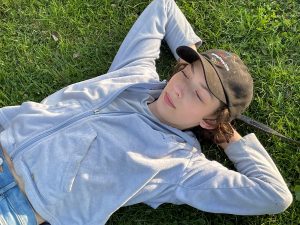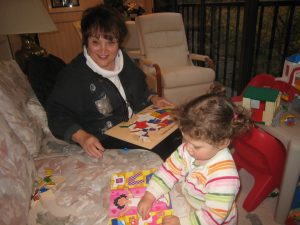
Jan 04 2022 Finding Quiet with Your Grandchildren
“Let us be silent that we may hear the whisper of G-d.” Ralph Waldo Emerson
We live in a fast-paced culture that values action and productivity. Our grandkids’ lives are often filled with noise (music, TV shows, toys that buzz and beep), stimulation (flickering screens, parents’ voices, ringing Zoom and phone calls), and activity (school, after-school classes, boisterous playdates).

There is a great gift we can give our grandchildren: the gift of quiet.
Quiet minimizes distractions, which helps children relax. And relaxation helps activate the brain’s hippocampus, which is important for building memories that support life skills like decision-making and empathy. As a result, during silent moments kids can streamline their thoughts, make sense of their emotions, and rewire their stress response.
When we turn down the outer noise it helps us find ways to turn down the inner noise as well, giving our grandchildren greater space to use their imaginations.
![]() Click HERE to read a National Geographic article on silence and kids’ mental health.
Click HERE to read a National Geographic article on silence and kids’ mental health.
![]()
![]()
![]()
Our tradition includes many examples of the power of silence, for example, “Shimon, [Rabban Gamaliel’s] son, used to say: ‘all my days I grew up among the sages, and I have found nothing better for a person than silence’” (Pirkei Avot 1:17). Silence is often a means to attention (“Silence, hear Israel!” Deut 27:9).
The following activities can help you enter a state of quietness with your grandchildren, whether you are together in person or on a videoconferencing platform.
1. Find the right time and model silent behavior.
Find a convenient time for yourself, your grandchildren, and their parents, who may need to coordinate, especially if you are long-distance. Notice the activity and stimulation around you and try to set it aside. Relax into quietness. Turn off devices (unless you are using them to connect to your grandchild) and block out anything that may compete for their attention—like siblings! Model silence yourself, for example, by driving with the radio off.

2. Plan activities that bring quiet attentiveness.
You can adapt the following ideas for long-distance, perhaps when you are on Zoom or Facetime together. Or send your grandchild short videos with prompts.
Nature

Together, sit on a bench, a log, or the front steps, or even stand at the open front door, and listen to the wind or the rain. Watch the first snowfall in silence. After a few minutes, quietly ask each other what sounds you hear (if any). Lie on the grass or sand on your backs on a towel or blanket, or spread out your coat, and watch the clouds together. What shapes can you each identify? Monsters, dragons, or fairies might just be up there; they will quickly be gone!
Listen for bird sounds. If you choose, try to identify the birds. For example, the blue jay has a distinctive cry that you can verify later by searching for “blue jay call” on your device.
In your home
Tiptoe through the apartment or house, listening for floorboards that creak. Sit quietly and listen for the footsteps — and jumping — in the apartment above. Have a whispering session where you communicate with your grandchild only in conspiratorial tones. Turn down the lights at bath time and turn off the loud extraction fan. Then tell your grandchildren a quiet story. They won’t take their eyes off you. And may even let you wash their hair!
Breathing and yoga

Do some mindful breathing together. Here are two calming breathing exercises for children. Or lead a ten-minute Tree of Life yoga class for just the two of you. Perhaps do some mindful walking. Try softly stroking your grandchild’s hair or arm while humming a gentle tune.
Art, reading, and puzzles
Do quiet art projects that focus attention with the minimum of words. Make a glitter jar or create a mandala. Each of you pick up a book and simply read silently next to one another. (This is ideal for Zoom too. Try not to sneak peeks at your grandchild’s adorable face!) Work on a jigsaw puzzle together. It need not be a teaching opportunity (“remember, the straight edges always go on the outside”); rather, make it a quiet “together” moment.
Richard Mahler in his brilliant book Stillness refers to silence and solitude as “creative allies” that we can “enlist in a personal campaign to create simpler, more balanced, less frenetic lives.” He says if we slow down, and “help the distracting exterior clamor to subside,” we will be able to really see, hear, and even feel what is going on inside us, within our hearts.
Mahler says, “getting away from it all helps us get close to it all. We are likely to be more at peace with ourselves when we occasionally stop to sit quietly and attentively.” Mahler calls this, “the undefined interior space.”
It is in that undefined interior space that we can have enriching and deeply meaningful experiences with our grandchildren.
Terry Kaye is Director of Creative Partnerships at the Jewish Grandparents Network and a longtime Jewish educator, author, and editor.
Nancy Siegel is an internationally recognized presenter, teacher trainer, and instructor specializing in mindfulness education and children’s yoga teacher training. For more in-depth Mindfulness virtual training, contact Nancy: nancysiegelconsulting@gmail.com, https://nancysiegelconsulting.com/. Visit her YouTube Channel
Photographic Credits
Photograph of smelling the roses by Nancy Siegel
All other photographs by Stephanie Fink




